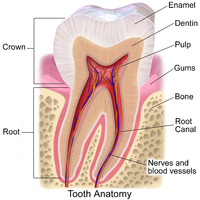
Photo from wikipedia
Human dental pulp stem cells (hDPSCs) are the primary cells responsible for dentin regeneration. Typically, in order to allow for odontoblastic differentiation, hDPSCs are cultured over weeks with differentiation-inducing factors… Click to show full abstract
Human dental pulp stem cells (hDPSCs) are the primary cells responsible for dentin regeneration. Typically, in order to allow for odontoblastic differentiation, hDPSCs are cultured over weeks with differentiation-inducing factors in a typical monolayered culture. However, monolayered cultures have significant drawbacks including inconsistent differentiation efficiency, require a higher BMP concentration than should be necessary, and require periodic treatment with BMPs for weeks to see results. To solve these problems, we developed a 3D-cell spheroid culture system for odontoblastic differentiation using microparticles with leaf-stacked structure (LSS), which allow for the sustained release of BMPs and adequate supply of oxygen in cell spheroids. BMPs were continuously released and maintained an effective concentration over 37 days. hDPSCs in the spheroid maintained their viability for 5 weeks, and the odontoblastic differentiation efficiency was increased significantly compared to monolayered cells. Finally, dentin-related features were detected in the spheroids containing BMPs-loaded microparticles after 5 weeks, suggesting that these hDPSC-LSS spheroids might be useful for dentin tissue regeneration.
Journal Title: Stem Cells International
Year Published: 2021
Link to full text (if available)
Share on Social Media: Sign Up to like & get
recommendations!